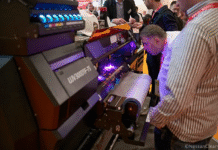Ohshika Printing has become Japan’s first printing company to receive the coveted Kodak Sonora Plates Green Leaf Award. It’s an honor well deserved for the 117-year-old printing company, which is a leader in UV packaging printing for a slew of popular Japanese snack brands and consumer goods. Since 2001, the company has made significant strides to reduce their environmental impact at its six manufacturing sites, where steps have been taken to reduce their energy consumption through the use of LED lighting, installation of solar panels and use of hybrid cars.
When Kodak first introduced the Sonora XJ Process Free Plates in 2015, Ohshika saw the potential to expand on its commitment to run a more sustainable printing operation. However, as a UV printer, Ohshika was cautious about switching to a new plate system, . “While we saw the potential for significant energy savings and elimination of processing, we were not sure if Sonora could handle the demands of our UV presses and provide the desired quality our customers demanded.”
The company’s caution turned to excitement after Ohshika began a thorough testing period. On an average month, the presses consume 5,000 plates to serve the needs of customers’ packaging jobs. Ohshika set a benchmark for testing at 30,000 impressions per plate. After a week of testing, Sonora proved it was fit for the job. The test demonstrated the UV plates are capable of delivering longer run lengths for UV print applications than any other process-free plate by offering consistent quality across all the impressions.
Hiroyuki Furuta, general manager at Ohshika said, “After the test, we felt confident that Sonora UV was the right fit for our operation. It can handle the complex and challenging jobs that we do every day for our customers, while also delivering a significant benefit to our bottom line and impact on the environment.” Since the initial testing period, Ohshika changed all of their plates to 100% Sonora XJ. The company’s general manager in the production department, Nobuyoshi Hamatake, commented, “I was worried that the move to a new plate would be challenging for my team, but with Kodak’s support, we were up and running very quickly. The transition was quite seamless for our company.”
The adoption of Sonora XJ is also improving the bottom line for Ohshika by helping the company eliminate chemical waste, all the costs associated with the disposal of hazardous liquids, and the related maintenance costs for the developer to the tune of 5 million Yen annually. In addition to the significant environmental improvements, Furuta and his team have been delighted by the on-machine image quality, especially with their oil-based printing and UV printing presses.
















